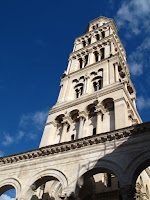


Sunshine returned to Croatia this morning, and we made the most of being on the spot, to walk the city walls in the early morning. This is the most popular tourist activity in Dubrovnik, which is not surprising, as they are considered the best city walls in the world.

We certainly agreed, and enjoyed walking the 2km complete circle, ahead of the throngs of tourists descending on the city in their bus loads. The medieval builders, who spent so much time and effort building the walls would be astounded to know that the result of their toil was now attracting rather than repelling the invading foreigners.



Then it was time to cross the nearby border into Montenegro. We had mentally planned to do this, after watching James Bond race around a stunning city in Montenegro, in 'Casino Royale', only to find out the filming actually took place in Loket, Czech Republic. Despite knowing this, we wanted to see the UNESCO region around Kotor, and the fishing village of Sveti Stefan.

Kotor is reached by driving alongside a huge inlet from the Adriatic that has at its peak a narrow channel leading to another large inlet comprised of two triangular bays that look somewhat like a bikini top thrown carelessly on the floor and despite appearing to be almost landlocked, the water is crystal clear. Not far, as the fish swims, from the top of the narrows is Perast but it is quite a drive to get there and at that point you are not even half-way to Kotor.

It is possible to take a ferry across the narrow channel, but the scenic drive around the entire coast-line is well worth the detour. We stopped at Perast, another picturesque old town before arriving at Kotor, situated down a long bay “dangling” from the second triangle, about as far from the open sea as possible. Despite that, there were cruise ships tied up in the harbour, this is obviously on the cruise ships itinerary, along with Dubrovnik.
The town is the typical warren of narrow streets, squares and the Orthodox churches had wonderful gold altar screens and icons. The walls here with regular towers, were quite an amazing feat of engineering, extending way up a bluff to the top of San Giovanni mountain.
F

rom Kotor we went overland until we got back to the Adriatic coast and then along to Budva, one of Montenegro's most popular towns. Before exploring it, we drove 5km further along the coast to Sveti Stefan. This former fishing village island, has just re-opened as a 5 star resort. But we were able to walk along their paved path for a closer look. Sadly, the renovations with crisp mono-tonal orange tile roofs, has lost the mellow look of earlier photos we had seen,

As we wanted to catch the island in the morning sun, we decided to spend the night at the nearby camp ground. There was a very smart illuminated sign on the roadside, which indicated a good standard of camp. The appearance of the owners should have warned us of the state of the amenities. They could have stood in for the inn owners in Les Miserables, and would probably received an Oscar for their excellent performances. He looked seedy and extremely dodgy type of character, she was the grasping/greedy type, who obviously didn't trust him with money. That didn't seem promising, and after viewing the state and standard of the amenities (whose floor area was probably smaller the the square footage of the sign!), we decided to drive back to Budva.

After enjoying dinner and a walk around the old town, where the shops were still open for business on Saturday night, we retired to our tent for the night. The guide book described Budva as having a lively night life. What this means for tired campers, is music playing at the local gig until 4am, interspersed with a large nearby dog barking at regular intervals and other campers returning from the 'lively night scene' at regular intervals!

 Bosnia is not a country we would ever have imagined visiting a few years ago, a bit like contemplating a holiday in Bagdad today! Signs of the war were everywhere, with derelict buildings, and pock-marked buildings and pavements.
Bosnia is not a country we would ever have imagined visiting a few years ago, a bit like contemplating a holiday in Bagdad today! Signs of the war were everywhere, with derelict buildings, and pock-marked buildings and pavements.

 The east bank of the river is the Muslim side, with more mosques, and a cemetery which is a very sad reminder of the war, all the dates of death seemed to be 1994. The west bank is the Catholic side, and we walked to see the Catholic church, which almost appears to be rivalling the mosques in the height of its tower. The
The east bank of the river is the Muslim side, with more mosques, and a cemetery which is a very sad reminder of the war, all the dates of death seemed to be 1994. The west bank is the Catholic side, and we walked to see the Catholic church, which almost appears to be rivalling the mosques in the height of its tower. The  main road running in front of it was the front line during the war.
main road running in front of it was the front line during the war. than any other and the stunning old towns make Croatia undeniably beautiful.
than any other and the stunning old towns make Croatia undeniably beautiful.












































